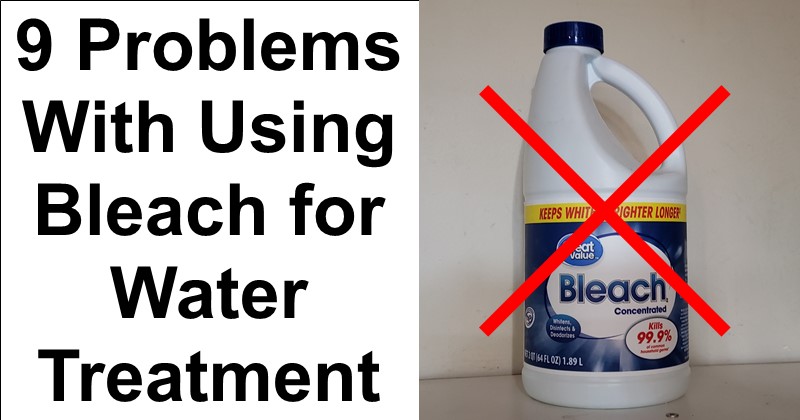I’m sure you’re aware that most authorities recommend you either boil water or use bleach (sodium hypochlorite) if you must treat water for some reason, such as a boil water order or you’ve run out of safe, stored water and now must collect from a questionable source.
Now, while I understand their reasoning–mostly likely because you’re expected to have bleach on hand–it’s just not that good of a choice, especially when there are better options in the form of quality gravity water filters. In fact, bleach would be an almost last-ditch effort to purify water in my household should the need arise.
Why? Here’s several reasons…
- For starters, bleach begins to lose it’s efficacy from the moment of manufacturer, NOT merely from the time you open the bottle. According to this article, “After a shelf life of six months, bleach starts to degrade. Even in its original bottle, bleach becomes 20 percent less effective as each year goes by.”
- Bleach also degrades when exposed to heat and light, thus, making it an even less effective disinfectant than you might realize if stored improperly.
- You must typically wait 30-60 minutes depending on water cloudiness for the bleach to fully take effect as a water disinfectant; consume water before then and you put yourself at risk of harmful pathogens having not been killed off yet. On the other hand, I’ve always thought that bleach will evaporate if left in an open container and/or exposed to the elements for days or weeks on end, but that’s apparently not true.
- A second dose of bleach may be necessary (or a bit more added to begin with) if the water is cloudy or dirty to ensure it’s been properly disinfected.
- With the above in mind, it’s also possible to both under-dose and overdose water when treating with bleach. Under-dosing leaves you vulnerable to getting sick, whereas overdosing with bleach could make you ill over time or, at the very least, be unpleasant to continually consume due to an off-putting taste.
- Bleach can be very harmful to you if mixed with some household cleaners–particularly ammonia and drain cleaners–due to toxic gasses being produced that can cause all sorts of ailments, from mild coughing and nausea to pneumonia and breathing problems, or worse. Even without being mixed, “Sodium hypochlorite at the concentration used in household bleach (5.25-6.15%) can produce ocular irritation or oropharyngeal, esophageal, and gastric burns,” as this CDC reference points out.
- As anyone who has accidentally spilled bleach on their clothing knows, it’s quite reactive to other materials, including discoloring clothing, irritating to mucous membranes and skin, corrosive to metals (especially stainless steel), and can be neutralized by some organic materials.
- Some bleach bottles contain perfumes, dyes, or other additives, none of which you want in your drinking water.
- Some bleach guidelines for proper dosage are obsolete because the older guidelines are for the traditional 5-6% sodium hypochlorite and not for the predominant 8% solution that’s now often sold in stores; here’s a reference I created a while back to correct the differences or one direct from the authorities.
On a positive note, bleach as a disinfectant isn’t all bad. Here’s a few positives to take note of:
- Bleach doesn’t kill off every harmful pathogen that can make you sick or, more precisely, may NOT kill every last pathogen because it’s not a perfect solution, but it does a pretty good job!
- Bleach makes an excellent surface disinfecting solution if used within the first 24 hours of mixing.
- It’s quite inexpensive and widely available almost everywhere.
While I understand that bleach is an easy, inexpensive option, there are many clearly detrimental problems with relying on bleach to treat water that you may need to survive! Do yourself a favor and buy a Big Berkey filter system like I have… it’s the best in the business and will provide for many thousands of gallons of clean, reliable drinking water for years to come. 🙂

Leave a Reply